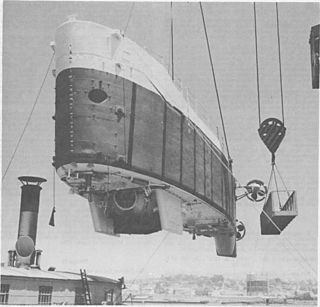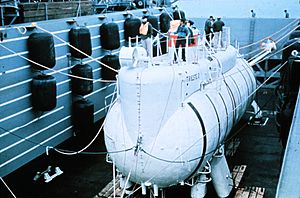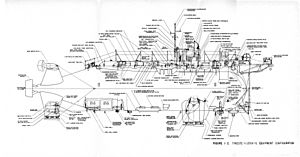Trieste II (Bathyscaphe) facts for kids
 |
|
Quick facts for kids History |
|
|---|---|
| Name | Trieste II |
| Builder | Mare Island Naval Shipyard |
| Completed | 1964 |
| In service | 1 September 1969 |
| Out of service | 1980 |
| Reclassified |
|
| Fate | Preserved at the Naval Undersea Museum |
| General characteristics | |
| Type | Deep-submergence vehicle |
| Displacement | 46 long tons (47 t) |
| Length | 67 ft (20 m) |
| Beam | 15 ft (4.6 m) |
| Draft | 12 ft 5 in (3.78 m) |
| Test depth | 20,000 ft (6,100 m) |
| Complement | 2 |
Trieste II (DSV-1) was a special kind of submarine called a bathyscaphe. It was built by the United States Navy and was even better than its older sister ship, the Trieste. These amazing vehicles are designed to go super deep into the ocean.
Contents
Exploring the Deep Ocean
The Trieste II was an improved version of the original Trieste. It was built at the Mare Island Naval Shipyard in California. The new Trieste II used the strong, round cabin (called a sphere) from the first Trieste. This sphere was made in Italy.
The sphere was attached to a new, more streamlined float. This float helped the bathyscaphe move better in the water. The Trieste II was finished in early 1964. It was then shipped to Boston on a transport ship called USNS Francis X. McGraw.
Searching for the USS Thresher
In September 1964, the Trieste II went on an important mission. It was commanded by Lt. Comdr. John B. Mooney Jr. and had co-pilot Lt. John H. Howland and Capt. Frank Andrews on board. They searched the area where the USS Thresher submarine had been lost.
The first Trieste had started this search the year before. The Trieste II was able to find pieces of the wreckage. This helped confirm that the remains were indeed from the lost Thresher.
New Designs and Deep Dives
Between 1965 and 1966, the Trieste II was changed a lot at the Mare Island Naval Shipyard. It got a new look and a new pressure sphere. This new sphere was designed to go even deeper, down to 20,000 feet (6,100 m) (about 6,096 meters).
The bathyscaphe continued to be used for testing new deep-sea technology. Four officers even became "hydronauts," which means they were trained to operate these deep-diving vehicles. The experience gained from Trieste II's deep dives helped engineers design other submersibles. These new vehicles could rescue crews and recover objects from submarines that were in trouble far below the surface.
For a while, the Navy just listed Trieste II as "equipment." But on September 1, 1969, it was officially put into service with the hull number X-1. Later, on June 1, 1971, it was reclassified as a deep submergence vehicle (DSV-1).
On April 25, 1972, Trieste II set a record! It recovered a satellite package, which was like a "bucket," from a depth of more than 16,000 feet (4,900 m) (about 4,877 meters). The Trieste II (DSV-1) continued to serve in the Pacific Fleet until 1980.
The Next Generation of Deep-Sea Vehicles
The Trieste class DSVs were eventually replaced by the Alvin class DSVs. A famous example is the Alvin (DSV-2). The Alvin vehicles are more capable and easier to steer. However, they cannot dive as deep as the Trieste II. The deepest an Alvin class vehicle can go is 20,000 feet (for the Sea Cliff (DSV-4)).
Today, the Trieste II is a museum ship. You can see it at the United States Naval Undersea Museum in Keyport, Washington.
Awards
The Trieste II and its crew earned several awards for their important work:
- Navy Unit Citation with star
- Meritorious Unit Commendation with star
- Navy E Ribbon
- National Defense Service Medal with star



